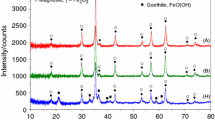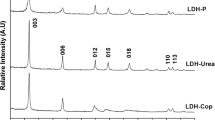Abstract
Dissolution of ceramic UO2 in aqueous Fe(NO3)3 solutions at different temperatures under the conditions of limited contact with air and in the autoclave mode was studied. In the course of UO2 dissolution at 60–90°C, the U/Fe molar ratio appears to be ∼1, whereas at room temperature (25°C) this value is ∼0.5. By varying the acidity of Fe nitrate solutions at these temperatures, it is possible to increase the U/Fe molar ratio to ∼4 and to obtain uranyl nitrate solutions with simultaneous removal of Fe from the solution in the form of a precipitate of the basic salt, or to perform quantitative dissolution of UO2 under the conditions excluding the formation of such precipitate. In the course of dissolution of ceramic UO2 in Fe(NO3)3 solutions, the appearance or absence of Fe(II) ions, the formation or absence of the precipitate of the Fe basic salt, and variation of solution pH are interrelated and are determined by the process temperature.
Similar content being viewed by others
References
Pasport federal’noi tselevoi programmy “Yadernye energotekhnologii novogo pokoleniya na period 2010-2015 godov i na perspektivu do 2020 goda” (Passport of the Federal Target Program “Nuclear Power Technologies of New Generation for the Period 2010-2015 and Their Prospects for the Period up to 2020”).
Adamov, E.O. and Orlov, V.V., in Tyazhelye zhidkometallicheskie teplonositeli v yadernykh tekhnologiyakh (Heavy Liquid Metal Coolants in Nuclear Technologies), Obninsk: Fiziko-Energeticheskii Inst., 1999, vol. 1, pp. 25–32.
Poplavskii, V.M., At. Energy, 2004, vol. 96, no. 5, pp. 301–307).
Reshetnikov, F.G., At. Energy, 2001, vol. 91, no. 6, pp. 998–1002).
Zilberman, B.Ya., Radiochemistry, 2000, vol. 42, no. 1, pp. 1–14).
Kulyako, Yu.M., Trofimov, T.I., Malikov, D.A., et al., Radiochemistry, 2010, vol. 52, no. 4, pp. 344–349.
Kulyako, Yu.M., Perevalov, S.A., Trofimov, T.I., et al., Radiochemistry, 2011, vol. 53, no. 6, pp. 608–611.
Author information
Authors and Affiliations
Corresponding author
Additional information
Original Russian Text © Yu.M. Kulyako, S.A. Perevalov, T.I. Trofimov, M.D. Samsonov, S.E. Vinokurov, D.A. Malikov, B.F. Myasoedov, 2014, published in Radiokhimiya, 2014, Vol. 56, No. 3, pp. 210–213.
Rights and permissions
About this article
Cite this article
Kulyako, Y.M., Perevalov, S.A., Trofimov, T.I. et al. Factors governing the efficiency of dissolution of UO2 ceramic pellets in aqueous solutions of iron nitrate. Radiochemistry 56, 247–251 (2014). https://doi.org/10.1134/S1066362214030059
Received:
Published:
Issue Date:
DOI: https://doi.org/10.1134/S1066362214030059




